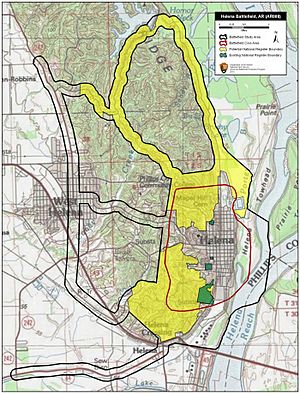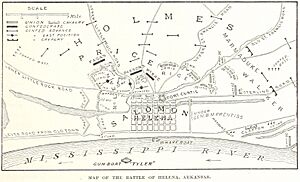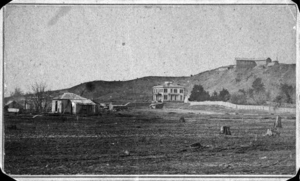Battle of Helena facts for kids
Quick facts for kids Battle of Helena |
|||||||
|---|---|---|---|---|---|---|---|
| Part of the Vicksburg Campaign | |||||||
 Helena Battlefield |
|||||||
|
|||||||
| Belligerents | |||||||
| Commanders and leaders | |||||||
|
|
|||||||
| Units involved | |||||||
| Strength | |||||||
| 4,129 | 7,646 | ||||||
| Casualties and losses | |||||||
| 239 total 57 killed 146 wounded 36 missing |
1,614 total 169 killed 659 wounded 786 missing |
||||||
The Battle of Helena was an important fight during the American Civil War. It happened on July 4, 1863, in Helena, Arkansas. The Confederate army tried to win this battle to help the city of Vicksburg, which was under attack. But they failed. The Union army won, and this victory helped them later capture Little Rock.
Contents
Why Was Helena Important?
Helena was a key city for the Union army. It was located on the Mississippi River, which was very important for moving supplies and troops. The Confederates wanted to take Helena to stop the Union from using it as a base. They also hoped it would take pressure off Vicksburg, another city the Union was trying to capture.
Who Planned the Attack?
Lieutenant-General Theophilus H. Holmes was the Confederate commander in Arkansas. He came up with a plan to attack Helena from three different sides. He got permission from General Edmund Kirby Smith to go ahead with his plan.
Confederate troops were gathered for the attack. Major-General Sterling Price led infantry (foot soldiers). Brigadier-General John S. Marmaduke led cavalry (soldiers on horseback). These two groups would meet up with more infantry led by Brigadier-General James Fleming Fagan. General Holmes himself went to Helena to lead the attack.
Who Defended Helena?
Major-General Benjamin Prentiss was in charge of the Union forces in Helena. He had about 20,000 troops at first. Brigadier-General Frederick Salomon was put in charge of the city's defenses.
Helena was a tough place to attack. It had steep hills and thick forests around it. The Union built four artillery batteries (places with big guns) and trenches in a semicircle around the town. A Union gunboat, the USS Tyler, was also there to help defend the city.
General Prentiss found out that an attack was coming. He tried to slow down the Confederates by cutting down trees in their path. Before the battle, many Union troops were sent to help with the attack on Vicksburg. This left only 4,129 Union soldiers to defend Helena.
The Battle Begins
General Holmes planned for the attack to start at dawn.
- Marmaduke's 1,700 cavalry soldiers were supposed to attack Rightor Hill, a fortified area northwest of town. They aimed to capture the artillery battery there.
- Fagan's 1,300 men were assigned to capture Hindman's Hill southwest of the city.
- Brigadier-General Lucius M. Walker was supposed to protect Marmaduke's side.
- The main attack was in the middle. Sterling Price's 3,100 men would try to take Graveyard Hill and its protecting battery.
Problems for the Confederates
Marmaduke's attack quickly ran into trouble. He was hit by artillery and small arms fire. Walker, who was supposed to help Marmaduke, did not. This caused a lot of bad feelings between them later.
The Confederate attacks on the southwest and center also had problems. There were misunderstandings about when to attack. General Holmes gave a vague order to "attack at daylight." Price thought this meant at sunrise, but Fagan thought it meant at first light.
Fagan's attack on Hindman Hill started first. He was surprised to be fired upon from Graveyard Hill. Fagan expected Price to be fighting there already. Fagan's own artillery couldn't reach the battlefield because of felled trees. So, his men had to attack the hill without their own big guns. They reached the outer defenses but were stopped by Union batteries.
Price's attack on the center started almost an hour later. His men charged the Union lines but were pushed back by heavy artillery fire from the batteries and the Tyler gunboat. Price's Confederates tried two more times. Finally, they managed to capture the guns on Graveyard Hill. But when they tried to use the guns, they found out the Union soldiers had disabled them.
Even with the mix-ups, the Confederates had some success. Fagan held most of the defenses to the southwest. Price held the high ground in the center. But General Holmes, who arrived on Graveyard Hill, didn't use this advantage well. He seemed unsure what to do. He gave confusing orders that didn't help any of his forces win.
The Confederate soldiers were now out in the open. Every Union gun still working, plus the big guns of the Tyler, fired at them. By 10:30 AM, Holmes realized his army couldn't win. He ordered a full retreat. The attack on Helena had failed.
What Happened Next?
The Union victory at Helena was very important. It meant the city stayed in Union hands. Helena then became a strong base for the Union army. Later that same year, the Union used Helena as a starting point to successfully capture the state capital of Arkansas, Little Rock.
Remembering the Battle
Today, you can find several markers and monuments in Helena that remember the battle. Groups like the American Battlefield Trust have worked to protect parts of the battlefield. They have saved about 56 acres of the land where the battle took place.
See also
Images for kids




